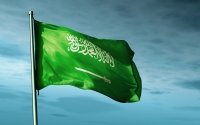
Yes, according to the Guidelines for the Use of the Saudi Arabian Flag, issued by the Ministry of Culture in 2023, digital designs must adhere to the specified color codes outlined in the guide. The flag must be placed within a designated safe space, where Al-Shahada occupies 70 percent of the image area displayed on the platform. When displaying the Saudi flag alongside another country's flag, the vertical and horizontal spacing between them should equal the height of Al-Shahada on the Sa...

The Saudi Flag is subject to a law stipulating the principles for flying the national flag and other related matters. The thirteenth article of the Law of the Flag of the Kingdom of Saudi Arabia, the national flag or any other Saudi flag bearing the Shahada (There is no God but Allah and Muhammad is the Messenger of Allah) or any Quranic verse may not be flown at half-mast. The Saudi National Flag should have the place of honor if raised alongside foreign flags or other banners. In all cases, t...

The Saudi Founding Day is a national occasion in the Kingdom of Saudi Arabia, commemorating the founding of the First Saudi State in 1727 by Imam Mohammed Bin Saud. It was approved by a Royal Decree issued by the Custodian of the Two Holy Mosques, King Salman Bin Abdulaziz Al Saud, on January 27, 2022. February 22 of each year is designated as the anniversary of the founding of the Kingdom and an official holiday. Contrary to popular belief about the modernity of the history of the Saudi state,...

The first Saudi flag was raised with the foundation of the First Saudi State in 1727 by Imam Mohammed Bin Saud , who made Diriyah the capital of the state. The first Saudi flag was hoisted on a simple mast and was green in color, made of khazz and ibreesim (silk and wool). The flag had the inscription of the shahada (Islamic declaration of faith): 'There is no God but Allah and Muhammad is the Messenger of Allah,' symbolizing the creed upon which the Saudi State was founded. The Saudi...

In the Kingdom of Saudi Arabia , general rules govern the raising of the national flag. These include the following: the Saudi flag must be flown at all government buildings and public institutions throughout the week, including weekends and holidays, from sunrise to sunset. When displayed in a public square or open space, the flagpole must be at least six m high. For flags raised on buildings, the pole height must be at least three m. In both cases, the width of the flag must not be less than ...

The National Symbols of the Kingdom of Saudi Arabia are visual or verbal representations or symbols of the characteristics of Saudi culture or Arab culture. Some hold official symbol status, being certified, approved, and regulated by the Royal Court , complete with enacted principles and guidelines. Examples include the Saudi national flag , the Saudi flag of His Majesty the King, and the official Saudi emblem. These symbols serve as focal points for media attention during national celebration...

The Founding King Abdulaziz Bin Abdulrahman Al Saud approved the shape of the Saudi flag on March 11, 1973. The Saudi flag has four standard shapes: Parade flag The parade flag is dedicated to outdoor events such as masts and military and sports parades. Its size is one hundred by 150 cm. Flag on a mast The flag on a mast is used for indoor events inside buildings and halls. Its size is eighty by 120 cm. Office flag The office flag is used on desks. Its size is sixteen by twenty-four cm. Car fl...

The Saudi National Flag is a national symbol of the Kingdom of Saudi Arabia. Its history dates back to the founding of the First Saudi State in 1727. The current form of the flag was approved during the reign of King Abdulaziz in 1937. A royal decree issued during the reign of King Faisal Bin Abdulaziz Al Saud in 1973 to approve its regulation as a national symbol. It is identical in principles, laws, and prohibitions to the King’s Saudi flag but differs in specifications. It is the only flag...

It is a national event that the Kingdom of Saudi Arabia celebrates on the anniversary of the establishment of the First Saudi State by Imam Muhammad bin Saud in 1727. This day was approved by a royal order from the Custodian of the Two Holy Mosques, King Salman bin Abdulaziz al-Saud, on January 27, 2022, which stipulated that February 22 of each year will mark the establishment of the Saudi State, and will become an official holiday. The Founding Day reflects the historical, civilizational, and...

The Saudi national flag incorporates several characteristics that distinguish it from the banners and flags of other countries. Throughout the history of the Kingdom of Saudi Arabia, the national flag has never been subjected to burning or destruction. In contrast to international customs of lowering flags to half-mast during tragic events or the passing of monarchs, it is not permitted to half-mast Saudi flags under any circumstances, whether it's the national flag, the royal flag of the ...

The Saudi National Anthem has been the official national anthem of the Kingdom of Saudi Arabia since 1984. It is also the royal salute performed at official ceremonies, receptions, and national occasions in Saudi Arabia. Composing the national anthem The lyrics of the national anthem were written by the Saudi poet Ibrahim Khafaji, by the order of King Khalid Bin Abdulaziz Al Saud, and suggested by Prince Abdullah al-Faisal Bin Abdulaziz. Upon the passing of King Khalid, King Fahd Bin Abdulaziz ...